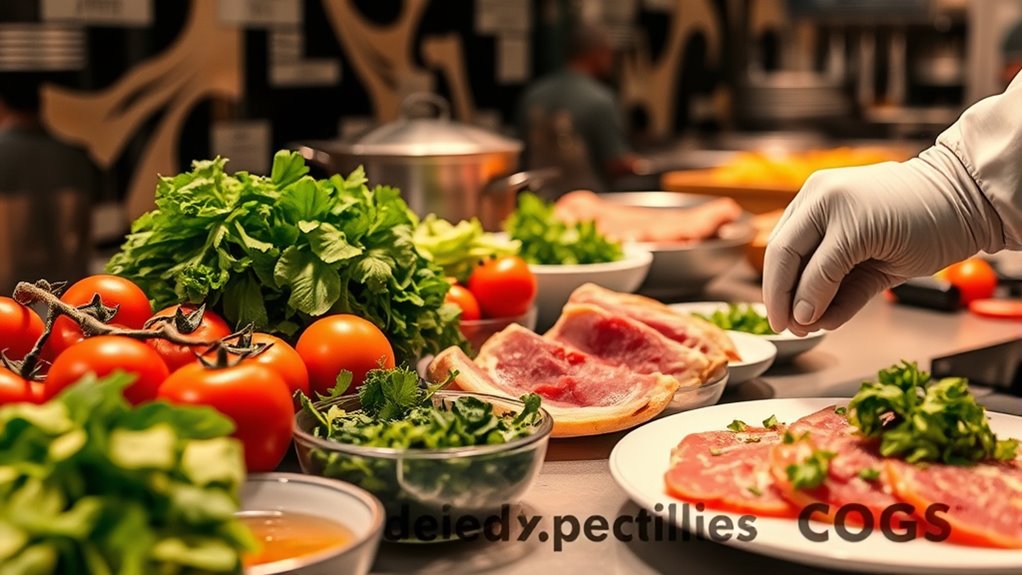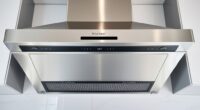In a restaurant, your COGS includes ingredients, beverages, pre-made items, kitchen supplies, packaging materials, food waste, employee costs directly related to production, and delivery expenses. It covers raw materials used to prepare dishes, drinks, and takeout packaging, along with costs from spoilage or waste. Managing these costs helps improve profit margins. Keep exploring to discover how tracking these elements can boost your restaurant’s efficiency and profitability.
Key Takeaways
- Raw ingredients and food supplies directly used in preparing menu items.
- Beverages, liquor, and pre-made food items consumed or sold.
- Kitchen utensils, packaging, and supplies that are used or consumed in service.
- Employee wages, tips, and benefits related to food production staff.
- Delivery, shipping, and procurement costs associated with sourcing ingredients and supplies.
Ingredients and Raw Materials
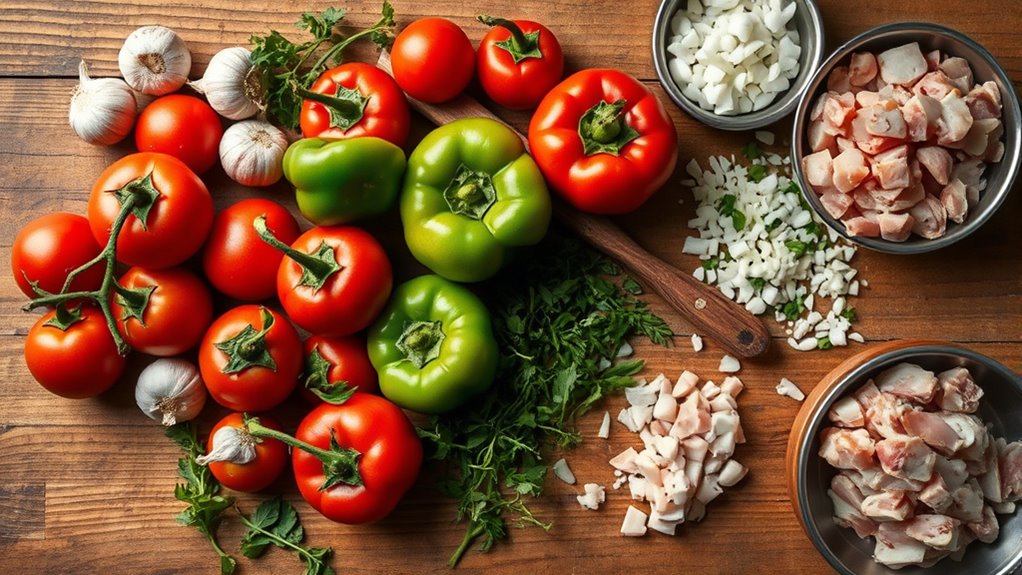
Ingredients and raw materials form the foundation of any restaurant’s menu, directly impacting both quality and costs. When you choose fresh produce, quality meats, and essential pantry staples, you set the stage for delicious dishes that customers will love. Managing these costs involves tracking inventory carefully, avoiding waste, and sourcing suppliers who offer competitive prices without sacrificing quality. You need to monitor usage rates closely so that you order the right amounts—neither too much nor too little. Proper portion control also helps prevent overuse of ingredients, which can inflate costs. Remember, the more efficiently you handle raw materials, the better your profit margins become. Keeping a tight rein on ingredient costs is key to maintaining a profitable and consistent restaurant operation. Inventory management plays a crucial role in controlling costs and ensuring the freshness of ingredients.
Beverages and Liquor Costs

Managing beverage and liquor costs is essential for maintaining your restaurant’s profitability. To do this effectively, you need to track how much you spend on alcohol and drinks compared to your sales. This includes all purchased liquors, beers, wines, mixers, and non-alcoholic beverages used for service. Regular inventory counts help identify waste, theft, or overpouring that can inflate costs. Implementing standard pour sizes and staff training reduces excess pouring. Keep an eye on supplier prices and negotiate better deals when possible. Monitoring your beverage cost percentage allows you to make informed pricing decisions and control expenses. By consistently overseeing these costs, you ensure your profit margins stay healthy and your drink offerings remain profitable. Transparency about cost control practices and accurate tracking are crucial for achieving these goals.
Kitchen Supplies and Utensils

Your kitchen supplies and utensils are essential for smooth operations, so it’s important to understand their costs. You’ll need to track expenses for both purchasing new tools and maintaining or replacing them over time. Keeping these costs in check helps you manage your overall COGS more effectively. Additionally, considering the durability and material quality of your utensils can influence long-term expenses and performance.
Essential Kitchen Tools
Having the right kitchen tools is essential for preparing delicious and efficient restaurant dishes. Proper tools streamline your workflow and guarantee consistent quality. Invest in durable, versatile equipment to handle daily demands. Key items include:
- Chef’s knives for precise cuts
- Cutting boards to prevent cross-contamination
- Mixing bowls for prep and presentation
- Baking sheets for roasting and baking
- Measuring cups and spoons for accuracy
These tools help you work efficiently, reduce waste, and maintain high standards. Regularly maintaining and replacing worn tools keeps everything running smoothly. Without the right kitchen essentials, prep becomes slower and less precise, affecting your overall service quality. Focus on quality, durability, and functionality to keep your kitchen running seamlessly and your dishes top-notch. Additionally, using multi-functional tools can optimize space and improve organization within your kitchen environment.
Utensil Expenses Overview
Are utensil expenses a significant part of your restaurant’s overall budget? They can add up quickly, especially if you frequently replace worn or damaged tools. Utensils include knives, spatulas, tongs, and ladles—essential for daily operations. While these costs might seem minor compared to ingredients or labor, they’re still part of your COGS. Properly tracking utensil expenses helps you manage inventory and control waste. You may purchase utensils in bulk to save money or opt for higher-quality items that last longer. Keep an eye on your spending to avoid unnecessary replacements. Additionally, investing in durable kitchen tools can reduce the frequency of replacements and save money in the long run. Remember, these expenses are ongoing, so including them in your regular cost analysis ensures you stay within budget and maintain efficient kitchen operations.
Maintenance and Replacement
Regular maintenance and timely replacement of kitchen supplies and utensils are essential to keep your operations running smoothly. When you regularly inspect and care for your equipment, you prevent costly breakdowns and ensure food safety. Replacing worn-out items promptly helps maintain efficiency and hygiene standards. Keep track of when supplies need attention to avoid disruptions during busy hours. Proper maintenance extends the lifespan of your utensils and reduces waste. Incorporating these practices:
- Schedule routine inspections for wear and damage
- Sharpen or replace dull knives and tools
- Clean and sanitize utensils daily
- Replenish stock of essential supplies before running out
- Discard damaged or unsafe equipment immediately
- Monitoring AI-driven maintenance tools can further optimize your kitchen operations and prevent unexpected failures.
Adopting these habits keeps your kitchen safe, efficient, and ready for service.
Packaging and Takeout Materials
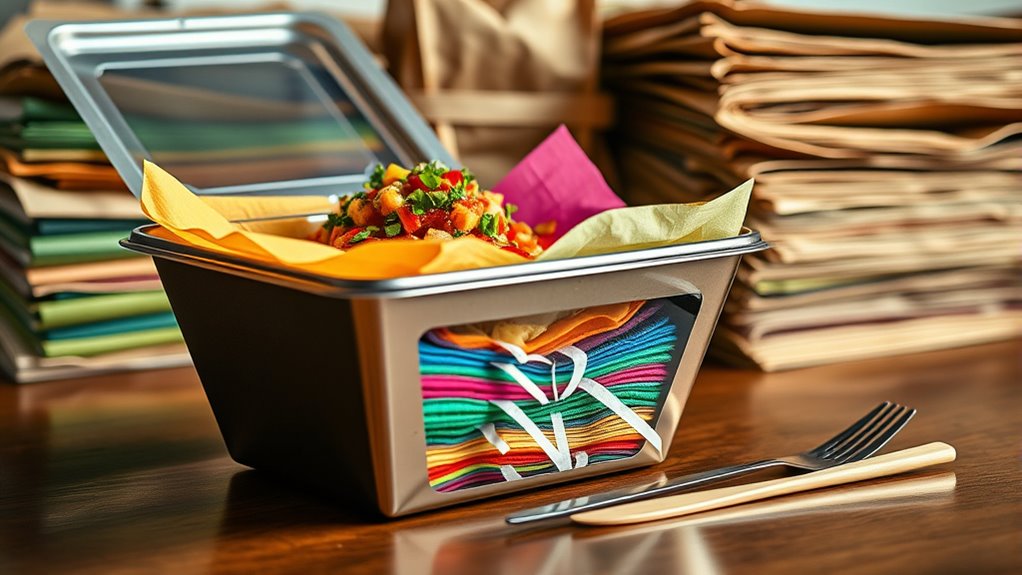
Your packaging supplies and takeout materials directly impact your food costs and profit margins. Tracking expenses for these items helps you manage costs effectively. Understanding how much you spend on packaging can improve your overall COGS management. Incorporating mindful cost analysis techniques can further optimize your spending and reduce waste.
Packaging Supplies Expense
Have you ever considered how packaging and takeout materials impact your restaurant’s costs? These supplies are a direct part of your COGS, affecting your profit margins. Properly tracking these expenses helps you understand the true cost of takeout and delivery. Packaging supplies include more than just boxes; they encompass everything from sauce containers to napkins. Managing these costs effectively guarantees you don’t overspend or run out of essentials during busy times. Keep an eye on:
- Takeout boxes and containers
- Food wrapping materials
- Napkins, utensils, and straws
- Bagging supplies
- Sealants and labels
Staying aware of these expenses helps you optimize your inventory and pricing strategies, ensuring profitability in your restaurant’s takeout operations. Monitoring raw food storage practices can further reduce waste and control costs.
Takeout Material Costs
Takeout material costs, including packaging and other takeout supplies, directly impact your restaurant’s expenses and profit margins. When you prepare to-go orders, the cost of containers, bags, napkins, utensils, and sauces adds up. These items are essential for ensuring customers receive their food in good condition, but they also represent a variable expense that can fluctuate based on demand. Managing these costs involves choosing cost-effective packaging without sacrificing quality or customer experience. Tracking these expenses carefully helps you understand their effect on your overall COGS. By negotiating with suppliers or sourcing bulk options, you can reduce waste and improve margins. Remember, takeout materials are a necessary part of your operation, but controlling their costs is *vital* for maintaining profitability. Monitoring cost control strategies can further optimize your expenses and ensure sustained success.
Food Waste and Spoilage
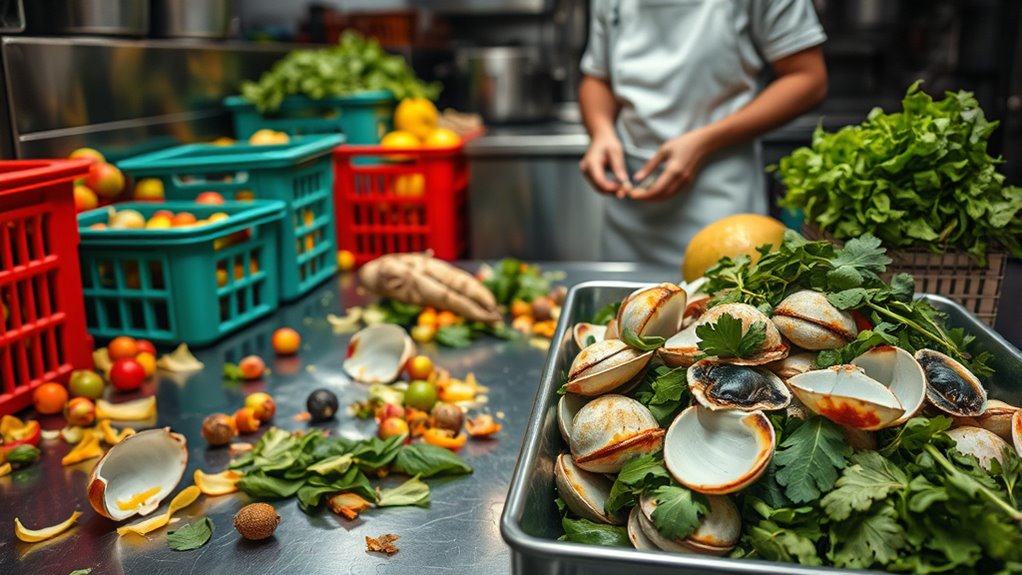
Food waste and spoilage greatly impact a restaurant’s cost of goods sold by directly reducing the amount of sellable inventory. When food spoils or gets discarded, you lose potential revenue and increase your overall food costs. Managing waste effectively can help lower COGS and improve profitability. To minimize waste, consider these strategies:
- Proper inventory rotation (FIFO)
- Accurate portion control
- Regular spoilage checks
- Efficient storage practices
- Using leftovers creatively
Implementing precise storage techniques can significantly reduce spoilage and extend the freshness of ingredients.
Employee-Related Costs Directly Tied to Production
How much do employee-related costs directly impact your restaurant’s production expenses? These costs include wages, tips, and benefits for staff involved in preparing and serving food. If your kitchen staff, line cooks, or prep workers are essential to creating dishes, their wages are part of your COGS. Similarly, tips paid to front-of-house staff directly tied to food service count as well. Benefits like health insurance or paid time off for employees involved in production also factor in. These costs fluctuate with production volume, so tracking them accurately helps determine true food costs. By including employee-related costs directly linked to making and serving food, you get a clearer picture of your restaurant’s true production expenses.
Purchased Prepared Foods and Pre-made Items
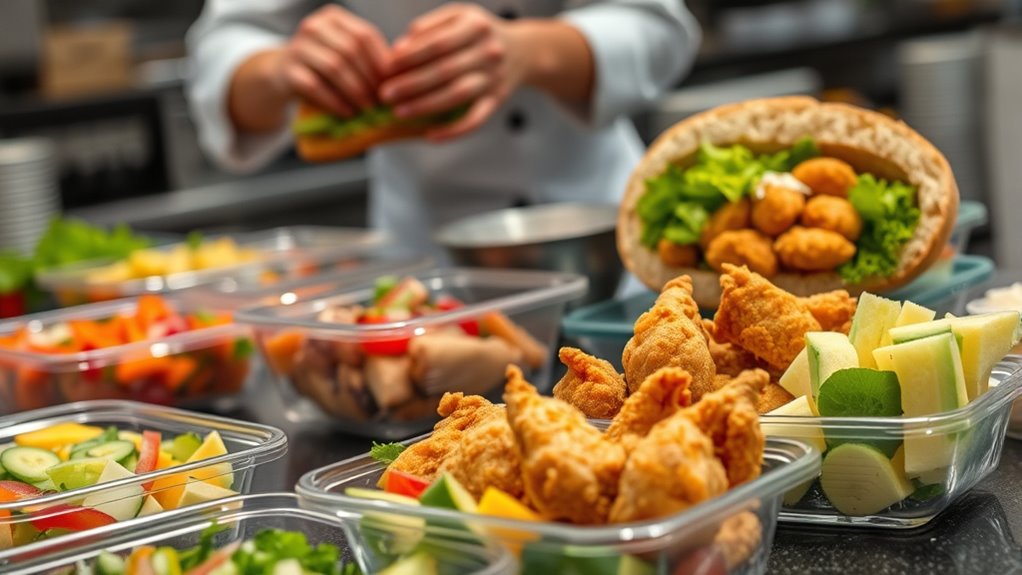
Purchased prepared foods and pre-made items can substantially impact your restaurant’s cost of goods sold because they are often convenient options that quickly add to your expenses. These items include everything from pre-washed salads to frozen desserts. They save time but often come with higher price tags, affecting your profit margins. To manage these costs, consider:
- Comparing supplier prices regularly
- Limiting reliance on pre-made ingredients
- Tracking usage and waste
- Negotiating bulk purchase discounts
- Balancing prepared items with made-from-scratch options
Delivery and Shipping Expenses for Supplies
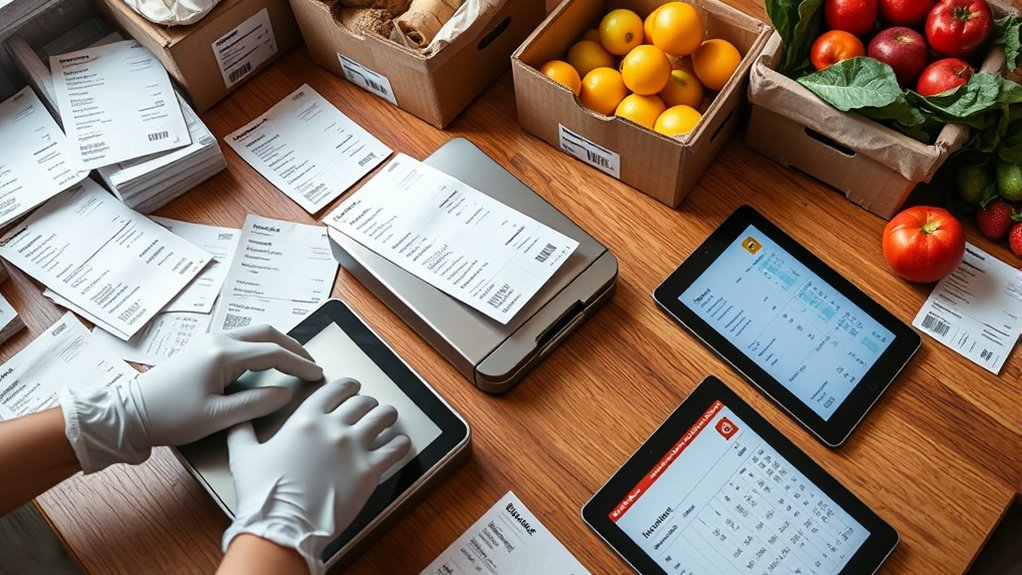
Managing delivery and shipping expenses for supplies is a key part of controlling your restaurant’s overall costs. These expenses include the fees you pay for courier services, freight, or shipping companies to deliver ingredients, equipment, or other necessary supplies. It’s important to track these costs accurately, as they directly impact your cost of goods sold (COGS). When evaluating your expenses, consider whether shipping charges are passed onto customers or absorbed by your business. If you negotiate bulk shipping rates or consolidate orders to reduce costs, document these efforts. Remember, consistent monitoring helps you identify opportunities to cut unnecessary shipping costs and improve your overall profitability. Properly accounting for delivery and shipping expenses ensures your COGS accurately reflects all costs involved in acquiring supplies.
Frequently Asked Questions
How Are Labor Costs Allocated to COGS?
When you consider how labor costs relate to COGS, think about direct employees involved in food prep and service. You allocate their wages, benefits, and payroll taxes to COGS because their work directly impacts food production. Keep in mind, however, that supervisory and administrative staff’s costs are usually categorized as operating expenses, not COGS. By accurately assigning labor costs, you guarantee your food cost margins are correct and reflect true operational expenses.
Do Marketing Expenses Count as COGS?
Your question about marketing expenses is important because they considerably impact your restaurant’s profitability. However, marketing costs don’t count as COGS—they’re considered operating expenses. COGS includes direct costs like ingredients and labor tied to food prep. Think of marketing as the engine driving customers in, but it’s not part of the food or beverage costs you sell. Managing marketing wisely helps boost sales without inflating your COGS.
Are Indirect Overhead Costs Included in COGS?
When considering whether indirect overhead costs are included in COGS, you should know that typically, they aren’t. COGS mainly covers direct costs like food, beverages, and labor directly involved in production. Indirect expenses such as rent, utilities, and administrative salaries are usually categorized as operating expenses. Keeping this distinction helps you accurately track your restaurant’s profitability and manage costs effectively.
How Do I Handle COGS for Seasonal Menus?
When managing COGS for seasonal menus, you should track the costs of ingredients, labor directly involved in preparing the dishes, and packaging specific to those items. Since seasonal menus change often, update your records regularly to reflect the actual costs. Allocate costs accurately for each season, and avoid including indirect overheads. This approach helps you understand profitability for each seasonal offering and adjust pricing or menu items accordingly.
What’S the Difference Between COGS and Operating Expenses?
Think of your business finances as a garden; COGS are the roots that directly feed your plants—food costs, ingredients, and packaging—while operating expenses are the watering cans and fertilizers that keep everything running smoothly. COGS are the direct costs of producing your meals, whereas operating expenses include rent, utilities, salaries, and marketing. Understanding this difference helps you nurture your restaurant’s health and growth effectively.
Conclusion
Understanding what counts as COGS for your restaurant helps you track expenses accurately and boost profitability. For example, if you buy fresh ingredients like vegetables and meats, those costs directly impact your COGS. By keeping a close eye on these, you can identify areas to cut waste or negotiate better prices. Remember, every dollar spent on raw materials or spoilage affects your bottom line—so stay vigilant and manage your costs wisely.
